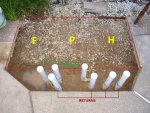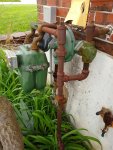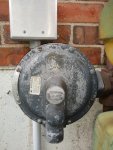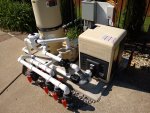- Nov 10, 2016
- 31
- Pool Size
- 28000
- Surface
- Vinyl
- Chlorine
- Salt Water Generator
- SWG Type
- Pentair Intellichlor IC-40
Hi, I have a limited space to work with and have never plumbed a complete system before. I've read until I can't absorb any more info and still have questions.
Planned layout:
The above ground plumbing will all be changed to 2" rigid Sch 40 PVC. Existing underground 1.5" PVC goes out to the pool via seven total circuits (SUCTION SIDE = skimmer 1, skimmer 2, main drain | RETURN SIDE = steps1, steps2, diagonal returns, feature jet). I have already cut and bushed these seven pipes near the equipment pad and attached short lengths of 2" PVC pipe (vertically) in preparation of adding valves and plumbing mostly new equipment in. Thanks to replies to my heater question here I will soon be purchasing a MasterTemp 250, possibly Cu Ni if the price makes sense. I will be installing an added electrical conduit and box near the side of the MasterTemp that extends power for the control panel function. A natural gas riser already exists; it has 1.25" MPT at its end which will need to be bushed down. The chlorinator is an existing IC40. The filter will be a Pentair FNS 60 and Pentair 2" multiport valve.. The pump is an almost new Pentair Variable flow.
RE: equipment inlets/outlets:
Per the IC40 there is supposed to be 12" - 18" of straight inlet pipe length. I may not be able to provide this. Is this of utmost importance or can I get by with 8-10" if necessary? If I need to add close to 18" the best bet may be to plumb it vertically, then provide a fairly short 180* set of elbows and bring the outlet back down parallel to the inlet. That said, is there a benefit to operating the IC40 either flowing in the uphill or downhill direction?
RE: filter and heater, what are the minimum straight pipe recommendations out from their respective multiport valve / header fittings? Can I plum elbows really close in any/all of these applications? I can find no specs for any brand, let alone Pentair. At least the pump states 10" of straight pipe before the inlet (with 2" pipe).
RE: heater:
I plan to run short sections of CPVC pipe and elbow right off of the inlet and outlets to be on the safe side heat-wise. What would be a good total pipe + elbow length in CPVC be before returning to standard Sch 40? I was thinking about 2 feet or up until the first device such as a check valve or Jandy valve.
RE: gas line connections:
Just curious what your observations or understanding of gas pipe plumbing at the unit is. My understanding, basically, is that one should bush down to 3/4", install the gas regulator, then a ball valve, then elbow(s) as necessary to reach the heater's inlet height, then a tee with a 3" sediment stub, then a union, then straight pipe the rest of the way inside the heater to the gas valve. Is this OK, or any corrections?
RE: gas regulation:
My regulator failed (blew out the diaphragm) a while back. I don't know anything about it other than it's likely at least 23 years old. Where could I go to match up a new unit that would have the same specs? I only know the heater requires 4"<14" water column of regulated pressure. I don't know what the pipe run delivers from the house. It is 1" CPS PE but that's all I know. The old heater was at least 250K and it worked great on this setup.
Thank you for any help!
Planned layout:
The above ground plumbing will all be changed to 2" rigid Sch 40 PVC. Existing underground 1.5" PVC goes out to the pool via seven total circuits (SUCTION SIDE = skimmer 1, skimmer 2, main drain | RETURN SIDE = steps1, steps2, diagonal returns, feature jet). I have already cut and bushed these seven pipes near the equipment pad and attached short lengths of 2" PVC pipe (vertically) in preparation of adding valves and plumbing mostly new equipment in. Thanks to replies to my heater question here I will soon be purchasing a MasterTemp 250, possibly Cu Ni if the price makes sense. I will be installing an added electrical conduit and box near the side of the MasterTemp that extends power for the control panel function. A natural gas riser already exists; it has 1.25" MPT at its end which will need to be bushed down. The chlorinator is an existing IC40. The filter will be a Pentair FNS 60 and Pentair 2" multiport valve.. The pump is an almost new Pentair Variable flow.
RE: equipment inlets/outlets:
Per the IC40 there is supposed to be 12" - 18" of straight inlet pipe length. I may not be able to provide this. Is this of utmost importance or can I get by with 8-10" if necessary? If I need to add close to 18" the best bet may be to plumb it vertically, then provide a fairly short 180* set of elbows and bring the outlet back down parallel to the inlet. That said, is there a benefit to operating the IC40 either flowing in the uphill or downhill direction?
RE: filter and heater, what are the minimum straight pipe recommendations out from their respective multiport valve / header fittings? Can I plum elbows really close in any/all of these applications? I can find no specs for any brand, let alone Pentair. At least the pump states 10" of straight pipe before the inlet (with 2" pipe).
RE: heater:
I plan to run short sections of CPVC pipe and elbow right off of the inlet and outlets to be on the safe side heat-wise. What would be a good total pipe + elbow length in CPVC be before returning to standard Sch 40? I was thinking about 2 feet or up until the first device such as a check valve or Jandy valve.
RE: gas line connections:
Just curious what your observations or understanding of gas pipe plumbing at the unit is. My understanding, basically, is that one should bush down to 3/4", install the gas regulator, then a ball valve, then elbow(s) as necessary to reach the heater's inlet height, then a tee with a 3" sediment stub, then a union, then straight pipe the rest of the way inside the heater to the gas valve. Is this OK, or any corrections?
RE: gas regulation:
My regulator failed (blew out the diaphragm) a while back. I don't know anything about it other than it's likely at least 23 years old. Where could I go to match up a new unit that would have the same specs? I only know the heater requires 4"<14" water column of regulated pressure. I don't know what the pipe run delivers from the house. It is 1" CPS PE but that's all I know. The old heater was at least 250K and it worked great on this setup.
Thank you for any help!









